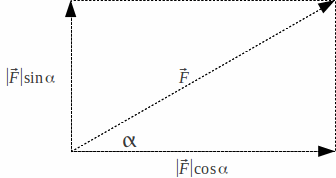The measurement of any quantity has a number and associated unit. Some quantities also need a direction to be fully defined. These quantities are called vectors. Those quantities that do not need a vector are called scalars.
Some examples are shown in the table.
|
Vectors |
Scalars |
|
Displacement |
Distance |
|
Velocity |
Speed |
|
Acceleration |
Mass |
|
Force |
Energy (kinetic, heat...) |
|
Momentum |
Temperature |
|
Electric field strength |
Potential or potential difference |
|
Magnetic field strength |
Density |
|
Gravitational field strength |
Area |
Vectors can be split into components. Often we want to split them into vertical and horizontal components:

These perpendicular components are independent of each other and can be analysed separately.
A vector is indicated with an arrow, and often written in bold. The length of the arrow representing the vector indicates the magnitude of the vector. Importantly, vectors can be added in a natural way, so that the vector representing the combination of two forces![]() and
and![]() is the sum
is the sum![]()

